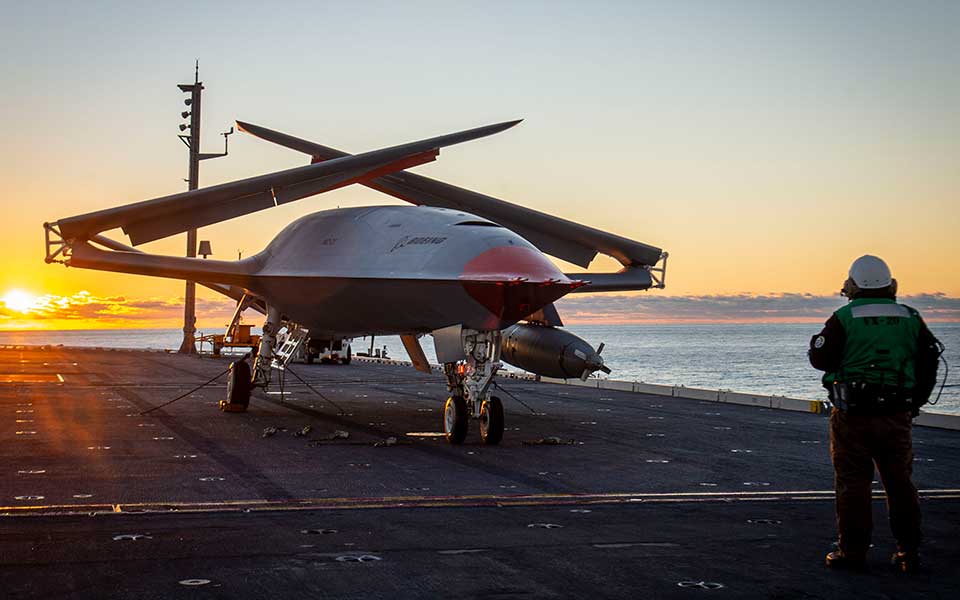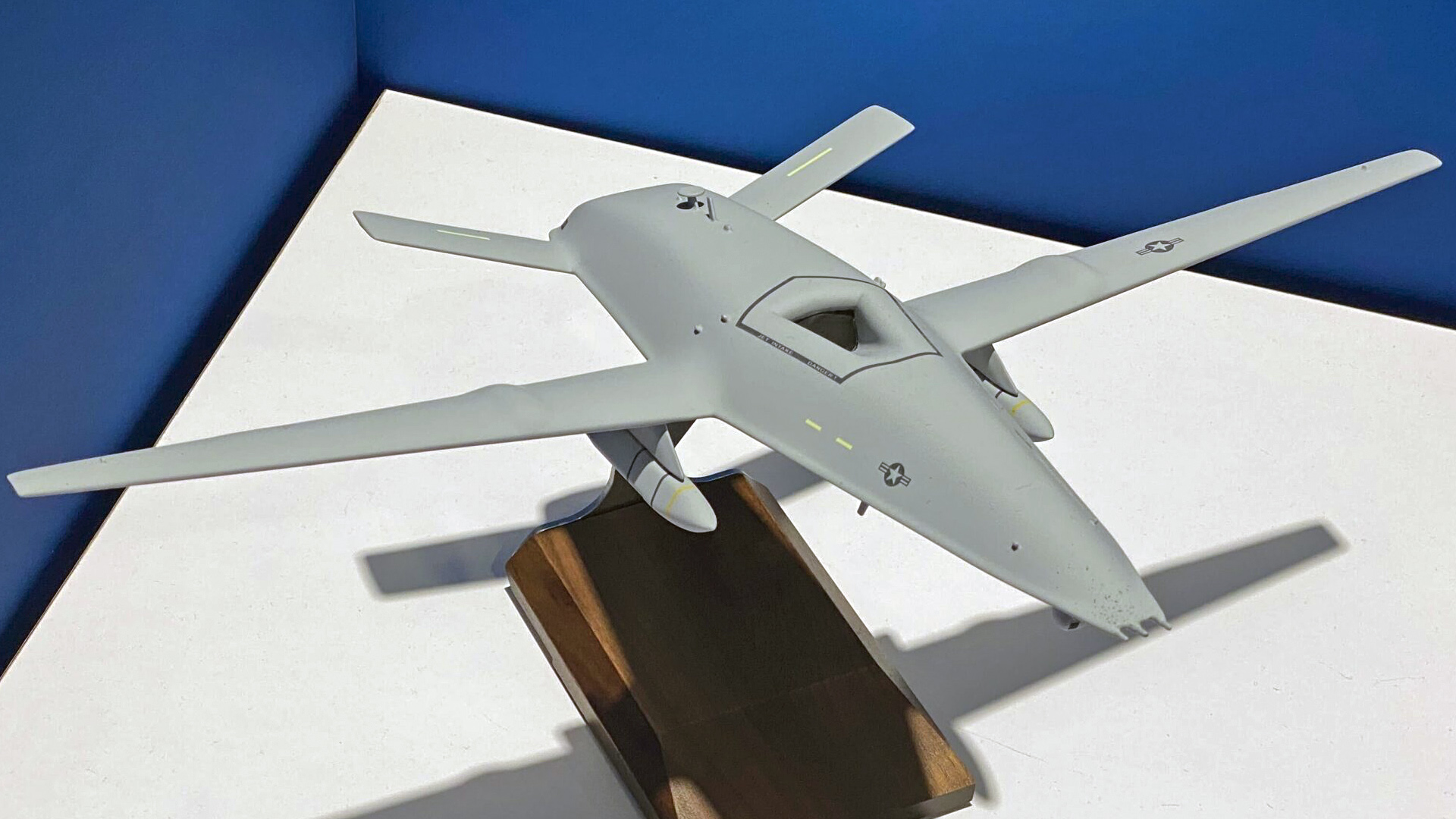Boeing has displayed a model of its MQ-25 Stingray carrier-based tanker drone armed with a pair of stealthy Lockheed Martin AGM-158C Long-Range Anti-Surface Missiles (LRASM). While the MQ-25 is yet to achieve initial operational capability in its basic aerial refueling role, the appearance of the model is significant, as the U.S. Navy begins to look again at expanded missions for the drone.
The model caught our eye at the Navy League’s Sea Air Space exposition in Maryland this week. The LRASMs appear to be mounted on the same underway pylons that would normally be fitted with refueling pods in the tanker version of the drone.

The MQ-25 originally emerged from the abortive Unmanned Carrier-Launched Airborne Surveillance and Strike (UCLASS) program, which would have involved a multi-role combat drone. This was controversially judged too ambitious and was superseded by the Carrier-Based Aerial Refuel System (CBARS) initiative that gave birth to the MQ-25 as we know it today. In the past, we have looked at the implications of this downscaling, from the original UCLASS stealthy strike/reconnaissance platform to a less capable tanker drone.
However, there have been suggestions in the past that the MQ-25 platform is still being eyed for a broader range of missions, including kinetic ones. Before Boeing won the contract to build the MQ-25, rival bidder Lockheed Martin was pitching a future strike mission for its own MQ-25 offering, going some way to restoring at least some aspects of the canceled UCLASS effort.
A Lockheed Martin animation from the 2018 Sea Air Space exposition showed its MQ-25 proposal delivering AGM-154 Joint Standoff Weapons (JSOW), as seen below:

For now, however, the Navy is focused on introducing the MQ-25 as a tanker to help extend the effective range of the carrier air wing and to eliminate the need for some of the F/A-18E/F Super Hornets in existing carrier air wings to perform tanker duties.
Beyond that, the Navy has identified a secondary intelligence, surveillance, and reconnaissance mission for the MQ-25. This includes an electro-optical sensor turret, but podded sensor systems could also be added in the future.
Giving the MQ-25 the capability to launch LRASM, and potentially other weapons, would be a significant new development.

Currently, the Super Hornet is the only Navy aircraft known to be capable of employing LRASM. The Navy is working to integrate the missile onto its P-8A Poseidon maritime patrol and surveillance aircraft and there are plans to add it to at least some F-35 Joint Strike Fighter variants, but for external carriage only. U.S. Air Force B-1B bombers can also employ LRASM.
The AGM-158C-1 version of LRASM now in service has a reported maximum range of between 200 and 300 miles. In the future, the AGM-158C-2 should extend the missile’s reach out to around 600 miles.
LRASM uses an onboard GPS-assisted inertial navigation system (INS) guidance system as well as a passive imaging infrared sensor for the terminal phase of flight, which autonomously selects the optimum place to strike the target. The missile packs a lot of other sophisticated tricks, including a datalink and a highly autonomous route-planning capability combined with an onboard electronic support measures (ESM) package that allows it to avoid threats and better detect potential targets. The missile is also designed to work cooperatively with other LRASMs during coordinated strikes, something you can read more about here.

All told, the LRASM would be expected to play a key role in a future high-end maritime conflict, of the kind that might be waged with China. In this scenario, the U.S. military would have to confront the People’s Liberation Army Navy, which continues to rapidly grow in size as well as add powerful new capabilities to its surface fleets.
Clearly, the more platforms that can deliver LRASM in this kind of scenario, the better for the U.S. military’s chances of success. Having the missiles on MQ-25s would enhance that. But MQ-25 actually offers some unique capabilities as an LRASM shooter that really makes great sense.
Boeing’s MQ-25 offering was adapted from a prior combat drone design, so it has a hybrid tanker-tactical aircraft design ‘DNA’ that would lend it to missions outside of tanking and basic ISR. It also clearly has many reduced observability characteristics, which would help in survivability. These were largely carried over from its origins as an unmanned combat air vehicle. But above all that, the MQ-25 will possess the longest combat radius of any potential ‘shooter’ in the carrier air wing. It is a flying gas can that can range out far from the carrier group to provide fuel, especially for thirsty fighters. With nothing to refuel, it can use all this gas for itself to go farther, giving the air wing a new lever of unrefueled reach. This could put it in a position to launch LRASMs at the edge of hotly contested territory. Considering the risks to carrier strike groups from China’s anti-access/area-denial arsenal, this could be critical as just getting close enough to put enemy ships, or even other targets, at risk will be a big challenge. This is a primary reason why the MQ-25 is being procured to begin with, to add to existing fighter’s reach so they could be relevant at all in a peer conflict.
Leveraging the MQ-25’s advanced communications suite, third-party targeting data can be provided to LRASM prior to launch, otherwise the missiles can be programmed to search out certain targets in defined geographical areas prior to the MQ-25 being sent on its way.
Finally, with no humans onboard, the MQ-25, at least in some circumstances, provides lower risk compared to its manned counterparts. While far from ‘attritable,’ these will be expensive and important assets, the loss of a crew doesn’t compare to losing a drone. Additionally, if one was shot down, it would not require an extremely risky combat search and rescue effort to try to retrieve an aircrew, a mission that could cost many more lives and pieces of precious equipment.
So yes, MQ-25 as a standoff weapons delivery truck makes a lot of sense and it would require limited integration to make it happen. One could even posit the reason the Navy doesn’t talk about the weaponization of the MQ-25 is for internal cultural and budgetary reasons, not because it isn’t relevant. That will likely change once it enters service and the program is on steady ground. In fact, versions of the aircraft could just be optimized for the UCAV role, allowing for commonality on future flight decks.
Finally, and more generally, having versions of the MQ-25 armed with LRASM, and likely other precision-guided standoff weapons, would fit with the Navy’s broader aspirations to have 60 percent of its carriers’ air wings unmanned by 2040.
As the first carrier-based uncrewed air vehicle in its class, the MQ-25 tanker is already playing an important role in working toward this. Adding potential new capabilities to the platform, and derivatives of it, would only help achieve this goal.

As we have discussed in the past, however, even getting the basic MQ-25 into carrier air wings in its initial tanker role may still present some significant challenges.
Late last year, the warned that the Navy was pushing ahead too fast in its plans for the MQ-25, adding new risks to the program in the process. At the same time, the U.S. military announced that Boeing was getting an additional $36 million to support MQ-25 development, specifically to help “mitigate component obsolescence” in six different subsystems.
Boeing’s MQ-25 submission was selected as the winner of CBARS in 2018 and the Navy subsequently laid out plans to buy 76 examples. This total comprises seven production-representative examples, 12 low-rate initial production (LRIP) models, and 57 more from full-rate production.
Over the course of the program so far there have been a variety of delays as well as growing costs. Back in 2018 it was predicted that the MQ-25 would reach initial operational capability (IOC) in 2024. That schedule slipped first to 2025 and then to 2026.

Speaking at the Sea Air Space exposition this week, RADM Stephen Tedford, the Navy’s program executive officer for unmanned aviation and strike weapons, confirmed that it was still planned to achieve IOC in FY 26. Before that, the drone will begin its Navy flight test program at Naval Air Station Patuxent River in Maryland, scheduled to start around April 2025.
Tedford described the MQ-25 as “our first step to the air wing of the future” and one that would take on the burden of aerial inflight refueling from the Super Hornet and return the F/A-18s “back to being tactical shooters.” Tedford added: “That’s what MQ-25 is all about.”
Boeing’s recent model suggests that, beyond this vital aerial refueling role, and potentially ISR, strike — specifically anti-shipping strike — could be the next mission in line for the MQ-25.
Contact the author: thomas@thewarzone.com
